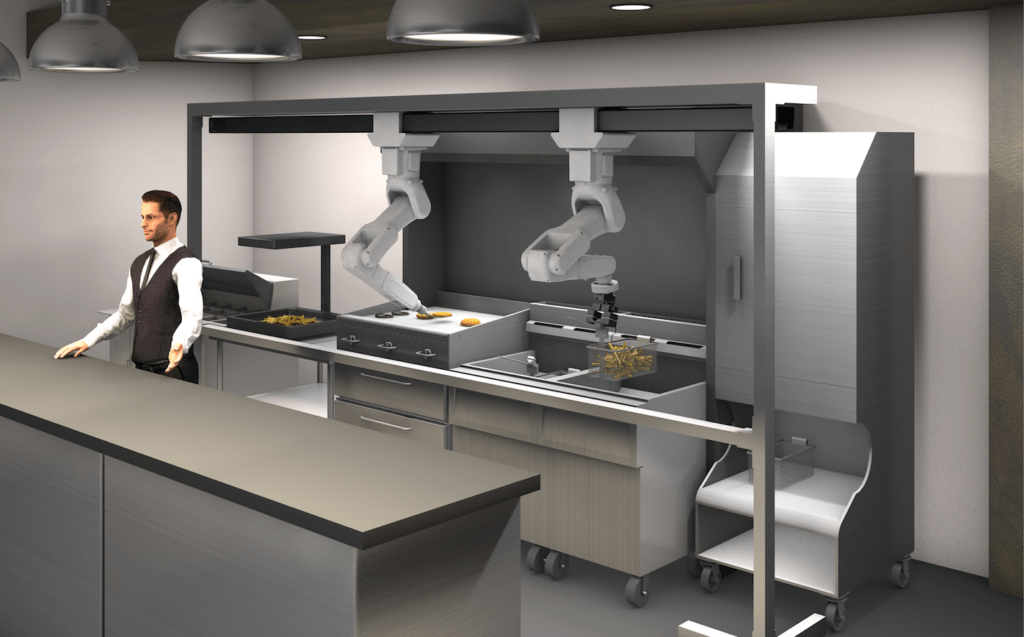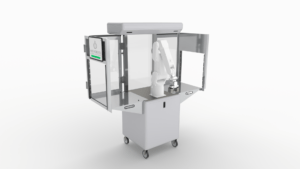
The new concept for Miso Robot on a Rail (ROAR) has a robot arm upside down on a rail system. Image: Miso Robotics
PASADENA, Calif. – Miso Robotics, which develops food automation robots for quick-service restaurants, today announced a new prototype that puts “Flippy” on a rail to perform extended capabilities for commercial kitchens.
Based on feedback from early Miso customers, the new Robot on a Rail (ROAR) concept puts the Flippy robot arm on an upside-down rail. The system is intended to be installed under a standard kitchen hood, and lets Flippy move along a line of kitchen equipment. The company said it anticipates ROAR to be commercially available by the end of this year.

The original cart-based Flippy robot. Image: Miso Robotics
The existing Flippy system is a cart-based robot with an arm and software intended to be placed in specific areas of a kitchen, such as at a grill (for making hamburgers), or at a deep fryer (for cooking fries, chicken nuggets, onion rings, etc.). The original Flippy has been deployed at multiple CaliBurger locations, as well as at concessions operations at Dodger Stadium in Los Angeles, and Chase Field in Arizona (for the Diamondbacks baseball team).
Buck Jordan, CEO of Miso Robotics, said the cart concept came with additional challenges, such human staffers needing to work around the cart, as well as workplace safety regulations and just taking up valuable floor space. The new concept is ultimately aimed to be “zero-footprint” as a way to lower the cost of automated kitchen equipment and offering “true end-to-end automated cooking services,” the company said.

Buck Jordan, Miso Robotics.
“It’s really challenging to take up floor space in a quick service restaurant kitchen,” said Jordan. “Quick serve restaurants are just like factories in terms of design, and you can’t take up space in the hallway, for fire codes and other reasons. So you really need an open kitchen to use our current format. By having [the new Flippy] be an overhead rail system, it just slides in, and is pretty easy to install, and it takes up zero square footage in the kitchen.”
With the rail system, the Flippy robot can now handle multiple cooking tasks, such as grilling burgers in once space, and then being able to move over to handle deep-frying activities, said Jordan.
AI upgrades for new food types, behavior
The company said it also made breakthroughs in the artificial intelligence software for Flippy, resulting in software that has expanded the food categories that Flippy can cook, including:
- Chicken wings, tenders, popcorn chicken, and bites
- Tater tots
- French fries, fresh or frozen
- Cheese sticks
- Potato wedges
- Corn dogs
- Popcorn shrimp
- Waffle fries (sweet potato and regular)
- Onion rings
Improvements were also made in the amount of time that the software can adapt to new food types. “The real revolution for us is that it’s becoming a lot easier – we can now add new food types within a span of a couple of hours, where it was days a few months ago,” said Jordan. “When we identify those food types, it’s with an extremely high degree of accuracy, that a McDonald’s or someone like that wouldn’t have a problem with the system doing that.”
Jordan said the Miso team was also working with the AI algorithm to understand the differences in cooking times for different food types and adapt accordingly so orders and food can be ready at the same time. For example, if one “steak” is ordered medium, and one is ordered medium-well, the system knows to start the medium-well item first, and then while that is cooking the system can check on other foods – or prepare something that takes a shorter amount of time should a new order come in. It’s in this way that the Flippy system acts more like how a human worker in a restaurant kitchen would work, rather than giving the robot a list of tasks to perform in a certain order before starting the next order.
Another benefit of the new design of Flippy is that it fits into the concept of “dark kitchens” – quick-serve restaurants that are designed specifically for delivery-only customers – with no front-of-house tables or customer floor space. “We think dark kitchens is the first place that automation really hits home,” said Jordan. “You’re not constrained by the existing kitchen – even though we’re designing it to fit quite nicely – it’s still nice to start with a fresh slate. I think that’s where brands are going to feel comfortable automating first. There’s a huge movement to automate kitchens, and dark kitchens go together, because they’re both tackling the same problem – the cost structure of restaurants. They’re tackling real estate, and we’re tackling labor.”
New crowdfunding approach
On the funding side, the company is on the verge of launching its crowdfunding campaign. In November 2019, the company announced it is seeking to raise $30 million through crowdfunding, with a minimum investment of $1,500. Pre-sale reservations have achieved $1.2 million, with the campaign set to launch in mid-February.
“Venture capital and early-stage investing is the most elite of elite games,” said Jordan. “You essentially have to more or less live in Los Angeles or New York, and be a highly credited person. Meanwhile, there are people all over the world who are excited to invest in Miso, and this gives them the opportunity.”
“One of the things that pushed us over the edge to make the decision is that the world and public has been wildly enthusiastic [about Flippy], way more than we would have expected about our product,” he added. “All the media we’ve had has been about 13 billion media views, and we weren’t going for that – but we’re happy to have it.”